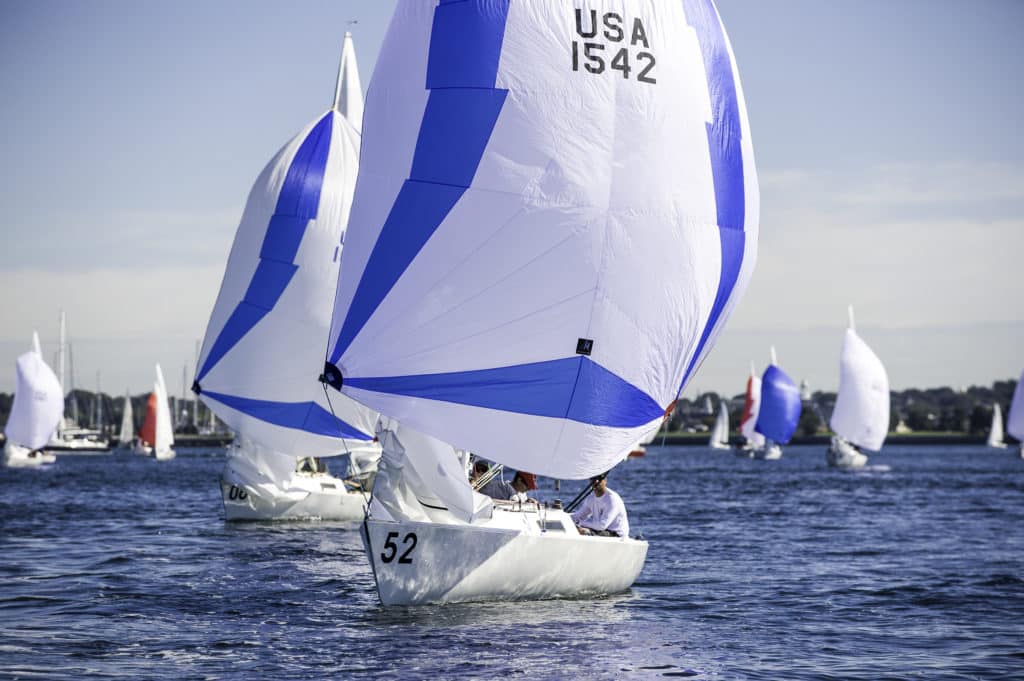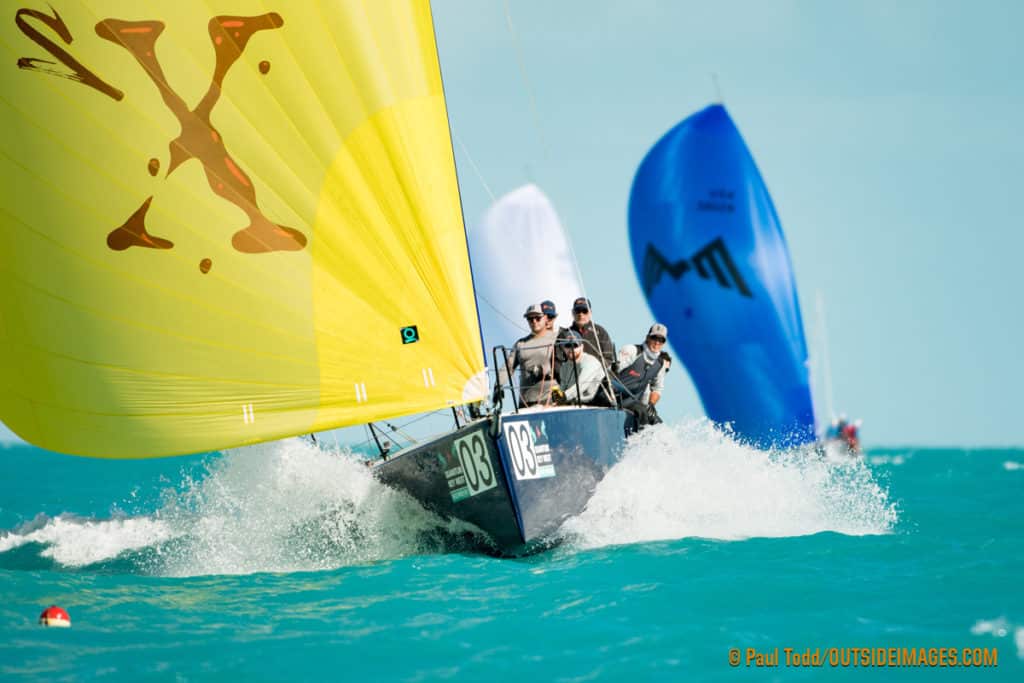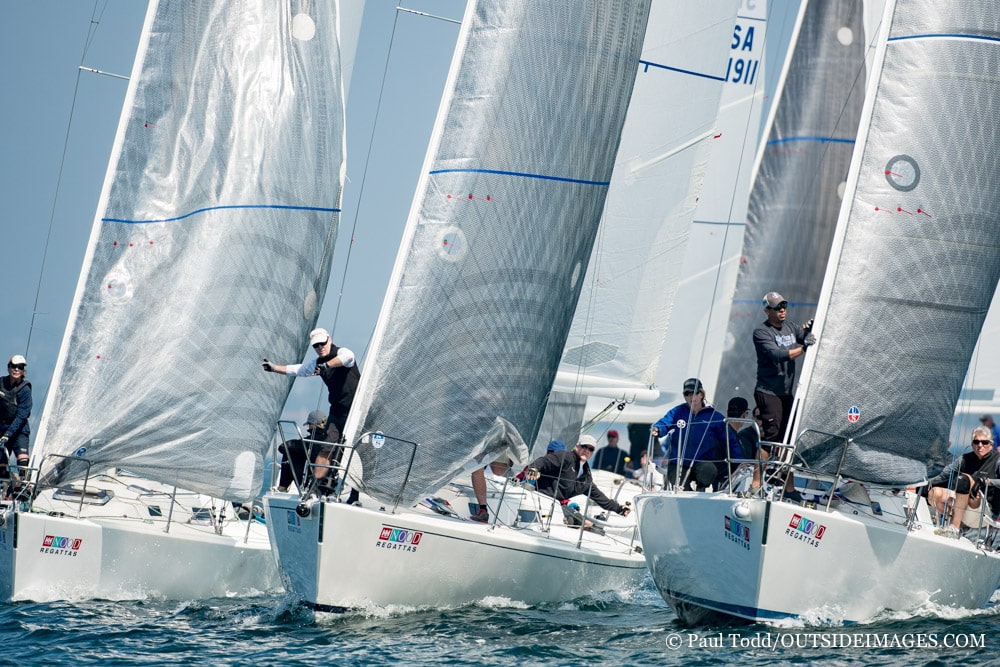
J 22 world Championship
Once upon a time, my teammates and I would start pre-race conversations with something like, “Let’s talk about weather conditions, geography and current, and come up with a plan.” But that’s a mouthful.
Then, one day, someone simply asked, “What kind of day is it?”
The question stuck, and since then, whether coaching or in my own racing, a pre-race discussion always starts with this very question. The answer, I’ve found, is essential to forming a strategy because, by categorizing the “kind of day,” we can be better prepared for the conditions we’re mostly to encounter.
Light Wind: Think observation and patience
Here, the overriding strategy is to sail toward wind velocity. When it’s blowing 4 knots, your boat might move at 2 knots, which is well below hull speed. In a puff, if the wind increases to 6 knots, you might sail twice that speed. No shift is big enough to make up for doubling your speed, so at almost all costs, sail to pressure in light winds.
Pressure might be geographic, like a wind line nearshore. It might be puffy, where you have to use one puff to take you to the next. Or the wind might come in lines from one side or the other.
Sometimes these puffs move down the course, so you have to line up with and intersect them; other times they move slowly, so you have to be patient and sail to them. Pre-race, have everyone stand up and observe while discussing the nature of the puffs.
I might say: “The wind is light today. There are streaks of puffs showing on the water. We need all eyes out of the boat.”
The tactician might respond with: “Let’s make sure to sail well into the puffs because they seem to move very slowly down the course. Tack too soon and they never will get to us.” Pay close attention to current. When boat speeds are low, current has a bigger relative effect. If the current is 0.2 knots and you’re moving at 2 knots, that’s still 10 percent of your speed. That said, I’ve found that blindly playing the current is not always the way to go. Since wind pressure will also significantly affect your speed, it is still important.
My tactician might say: “See those puffs on the water? I would like to sail solidly into one of those then take it toward shore to get current relief. We can’t cross the middle in a lull because the current is too strong there, so let’s wait for some pressure before tacking.”
Typically, a light-wind day is not ideal for playing shifts. Only very large shifts are worth considering, and even then, they should be used to deliver you to the next pressure. It’s all patience. Things will happen slowly, so look way ahead, trust what you see, and stick with the plan. Tack sparingly and wisely.
Medium Wind: Be tactical
When it’s windy enough to get up to hull speed, more pressure has only an incremental effect. Suppose it’s blowing 10 knots, and your boat is at its 6-knot hull speed. If a puff blows 2 knots more, you might go only 6.2 knots and point a little higher. That’s nothing compared with light wind, where you can easily double your speed. Sure, pressure is important, and I’ll take that incremental gain anytime, but I am looking for things that will make a bigger difference.
Playing oscillations by tacking when you’re heading below the mean is a classic medium-wind strategy. In these conditions, prioritize finding and agreeing on a mean. It should be a collaborative effort, but one person should take the lead.
Pre-race and during that race, this person records numbers about every minute, or when something changes. A simple way to get started is to make your first guess the middle of the recorded high and low. Then skew it one way or the other if you find your compass headings are not equal on both sides of your first guess.
Sometimes in this condition you will see puffs on the water and, even though you are not prioritizing pressure, with them often comes a directional change you can take advantage of. Ideally you can take a lift (or at least a neutral heading) toward a puff. If it’s a header, tack, but if it is an even bigger lift, just keep going. Either way, when you get to the puff, you can take advantage of whatever shift it brings and, as a bonus, you are in more wind — all is good.
Other times the shifts are subtle, and you will not see them on the water. React to those by keeping a close eye on the compass. On this kind of day, spend significant pre-race time close-hauled, writing down compass headings, then agree on a mean for each tack.
Our tactician starts with: “It’s medium air, so shifts are more important than pressure. The puffs seem to be righties, so let’s take the lighter lefties to the puffs and expect to be tacking when we get to them.” I agree: “Let’s go close-hauled again so you can double-check your compass numbers.”
He adds: “But not all the puffs are righties, and not all the lulls are lefties. We need to be flexible and prioritize the lifted tack over puffs.” In medium wind, geographic effects can be significant.
For example, because of both flatter water and the bend of the wind perpendicular to shore, getting to an edge nearshore can be powerful. Another example is the mouth of a bay where the wind funnels in and compresses against the sides of the entrance.
Current matters too, but less than in light air. If the current is .2 knots and your hull speed is 5 knots, that’s 4 percent and still well-worth making part of the plan. Playing shifts to the side with geographic or current help is often the winning move.

Heavy Wind: Hang on and go fast
On a heavy-wind day, avoid excessive maneuvers. Tacks are slow relative to going fast in a straight line. Maneuvers are also tiring, and when things can go wrong, they go very wrong; it’s best to keep them to a minimum. I’ll say: “Today is windy and wavy. I think we can get to flatter water on the left, so let’s head to shore on starboard tack.”
Our tactician responds: “We will likely get a geographic lefty out there too, so let’s make sure to set up our start with as big a hole to leeward as possible. We really need to hold on starboard for a long time.”
The trimmer chimes in: “Let’s minimize tacks. If all goes well, we can go almost to layline. But if not, let’s not do more than four tacks on the first beat.”
A windy day is a day to play oscillating shifts, but the windier and wavier it is, the more significant the shift must be to make up for speed loss during tacks. Sailing to pressure gives only incremental gains, or might even hurt you if it’s blowing hard enough. The priorities are usually seeking out flatter, protected water, current advantage and geographic shifts.
Unpredictable Conditions: Stay alert
A random day is one of those days when puffs seem to come out of nowhere. These days occur when there’s an unstable system, when the water is warmer than the air (making the surface wind warm and unstable), or when the wind is coming off hills or hot land.
Don’t bother looking at the compass. Instead, keep your head up and be quick to react to whatever comes your way — the lifted tack should be obvious. If the jib luffs when a puff hits, just auto-tack; if not, keep going.
When it’s random, I might say: “I can’t find any pattern today. Let’s stop trying to make sense of it and just react. I want everyone’s eyes out of the boat, and let’s hear a lot of chatter about what you see so we minimize surprises.” Then, while racing, as a big puff appears in our path, I like to ask my tactician how he wants to handle that next shift: “If this is an auto-tack, do you want me to tack?”
The default I expect to hear is, “Yes, if your jib backs, tack,” but occasionally he will say something like: “No, hold this tack no matter what. We are out at the edge of the course already,” or “No, the front edge of these puffs are big headers, but that lasts only a few seconds, so tough it out and get through without tacking.”
On a random day, don’t try to cover the fleet; it can easily put you out of phase.
Persistent Shift day: These are difficult to recognize
Any wind strength can have a persistent shift. The problem is it’s hard to recognize. Keep an eye out for a couple of different kinds of persistent shifts.
A persistent shift can be a slow over many hours. While these are incredibly important for a distance race, they will have almost no effect on a short course. For example, if the forecast is for the wind to go 20 degrees right over 10 hours, it will shift on average 2 degrees per hour. That is only 0.5 degrees per 15-minute leg, which is insignificant compared with oscillations we typically follow on the compass.
When that’s happening, I might say: “The wind is forecast to clock right today. But it is happening slowly and the oscillations are 10 degrees, so let’s just play the oscillations.” My tactician adds: “I will make sure to adjust our mean occasionally to reflect the expected shift.”
A persistent shift often comes all at once as a new wind fills in. In lighter air, it’s easier to see because the filling breeze brings both angle and pressure from that side. It might fill in because of a thermal, or it might be a front. Look for any sign that might give some clue of what is coming. Those puffy clouds onshore might precede and predict a thermal. A front often comes with a line of low, dark frontal clouds. Look for darker water moving your way, flags or smoke shifting on shore, and sailboats (both in your race and farther away) sailing in something different than you are sailing in. These are all signs of a persistent shift filling in quickly.
On a day when we think a big shift is inevitable, I might say: “It’s a dying northerly this morning. We expect the southwest thermal to come in sometime early afternoon.”
My tactician adds: “We need to sail in what we have right now, but let’s keep our eyes out for the new wind. We need to be the first to see it and head that way.”
The most challenging persistent shift is one that lasts for a whole leg; therefore, for that leg it is persistent. Suppose you observe major oscillations coming through every 20 minutes or so. If each leg is only 15 minutes, you might get one major shift per leg — or not. There is often no pattern, and the reality is that a shift could come in five minutes or 30 minutes. When it’s like this, don’t give your competitors too much leverage. If you think it will shift right and your competition goes left, stay to the right of them. You will still gain if you are correct, but if you are wrong, you won’t be so far back from the pack that you can’t do some damage control. It’s a tough day to be a tactician, so be forgiving; they will not always get it right.
Sometimes there are signs that hint a persistent shift will hold for the remainder of that leg, like when it is a stormy day with small cells coming through the course. These cells shift the wind in the direction from which the clouds are coming. It holds steady while the clouds pass, then shifts back to the original direction after they pass.
What might I say here? “Today is kind of blustery. When we see a darker cloud coming, we need to head toward it at all costs. When we get to it, expect increased pressure and a header, so we will tack soon after it hits because it will likely lift us to the mark quickly.”

Hybrid Conditions: Use a mixed strategy
The reality is that there is rarely a pure kind of day as laid out in the previous scenarios. Instead, there is usually some mix of priorities to create the winning plan for the day. If I were sailing a dinghy, here is how the conversation might go: Tactician: “Today is tough. The right has geographic pressure nearshore, but although the current is not ripping, it favors the opposite side — the left. And to confuse our choices further, we have big oscillations. Since we are sailing at hull speed, they are more important than pressure.”
What to do? Prioritize. Identify the most important factors and give them a weight.
- 50 percent oscillating shifts: They are big, and it is medium air, so shifts are important.
- 30 percent geographic right: Not as important as the oscillating shifts but still significant.
- 20 percent current left: Current is light but still has an impact.
The three conflicting factors are now put in perspective. Shifts at 50 percent are as important as geography and current combined, so they are for sure the main focus. The current and geography directly conflict, but they’re pretty close in importance, so we are not going to stress either one.
Our final strategy is summed up this way: “Our top priority is shifts. If in doubt, we will work right for the geographic righty late in the leg. But if the shifts take us left, it’s not all bad. We have some current relief there.”
There’s one final caveat for boat-specific conditions. Not all strategies work for all types of boats. For instance, a catamaran, skiff or foiling boat that goes 20 knots upwind will go only a few knots while tacking. A keelboat tacks OK, but there is still a loss. But a round-bottomed dinghy in flat water might have almost no loss at all. A fast boat is sensitive to pressure. Where a keelboat or dinghy gets up to a hull speed of, say, 6 knots in a low-wind range, a skiff or cat gets faster and faster as the wind comes on. Current affects fast boats less because the speeds are high compared with the current.









